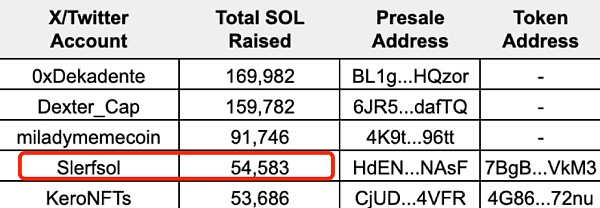Source: Beosin
Recently, SLERF has become the most watched project in the encryption market. Originally, SLERF may have been just one of the many meme coins in the Solana ecosystem. However, with a series of events such as the founder of SLERF losing the right to mint coins, destroying LP and airdrop reserved tokens due to misoperation, and apologizing and crying on Twitter Space, etc. After fermentation,SLERF has become the most popular meme currency on the Solana chain, with a market value of over US$600 million.
SLERF put on a big show for the entire crypto community and became the new king of memes. After watching the show, if we think back carefully, we will find that a series of wrong operations by the founder of SLERF caused huge losses to its investors. How should Web3 project parties avoid similar mistakes and losses? Today Beosin will answer the question for you.
SLERF event progress
Amid the craze of Solana meme coins, SLERF raised 54,583 $SOL (approximately 10 million US dollars) in just a few days, becoming the Solana meme token The fourth largest project in pre-sale.
 source: https://twitter.com/zachxbt/status/1770138079044485357
source: https://twitter.com/zachxbt/status/1770138079044485357
However, SLERF is different from other meme coins in that theSLERF team tweeted Due to a mistake, they destroyed $10 million in pre-sale tokens and lost their minting rights. This resulted in SLERF being unable to pay corresponding tokens to investors in its pre-sale.

SLERF's The burn unexpectedly plunges the token into deflation, and SLERF’s transaction fees will also reduce its supply. Such a dramatic event coupled with the benefits of token destruction, since the destruction event, SLERF has been listed for trading on many centralized exchanges such as KuCoin, HTX, LBank, and decentralized exchanges such as Raydium on Solana. It is worth noting that SLERF Transaction volume on Raydium has exploded, with transaction volume exceeding $7.1 billion.
At the same time, the plan to “rescue SLERF pre-sale participants” is also widely discussed in the encryption community. SLERF has launched a donation campaign, and all donated funds will be used to compensate pre-sale participants. LBank served as the first donor and donation address custodian in this compensation action, and many users in the crypto community also participated. In addition, some exchanges such as HTX and Bitget announced that they would reimburse pre-sale investors who suffered heavy losseswith all fees incurred from SLERF transactions. With the help of all parties, the losses caused by the Slerf team have a feasible compensation plan.
How do SLERF errors occur?
First, let’s take a look at how SLERF caused over $10 million in losses. According to SLERF’s official statement, its founder wanted to destroy LP but failed, and then used Sol Incinerator’s destruction program, which resulted in the destruction of all tokens in his wallet:

Looking at a series of operations on the SLERF pre-sale address HdENn8wP6srk1AuE2CaJj6bRbjcU2kYs12H4C4HgNAsF, we found that SLERF’s statement is true.
At 14:53 Beijing time on March 18, SLERF created LP on Raydium, a decentralized exchange on the Solana chain:
< img src="https://img.jinse.cn/7197561_image3.png">Txn link: https://solscan.io/tx/pbhuNHGP2gFoUGrrcEVqZHNt7zJXYPX2JuSRvMoSPr6R1s63EpHrf4VZsXyjz6 SGopAwcu5Cw4XMW52FbosV16k< /span>
Six minutes later, the address called Sol Incinerator to destroy all altcoins in its wallet, including 500 million SLERF. At this point, SLERF has destroyed half of the tokens and pre-sold SOL, causing irreparable losses.
 Txn link: https://solscan.io/tx/hzVc7DevXGi3DKEyrR23PVV6DRmpA1LgnwUeQkNjnm42tQ7rGipATsLuuSnEaKVbDahWJnwbm2ZGWEF4CTwaBMG
Txn link: https://solscan.io/tx/hzVc7DevXGi3DKEyrR23PVV6DRmpA1LgnwUeQkNjnm42tQ7rGipATsLuuSnEaKVbDahWJnwbm2ZGWEF4CTwaBMG
Where Sol Incinerator is Solana's "Incinerator" "furnace", used to destroy various Tokens and NFTs, clean up useless blockchain space, thereby recycling a certain amount of Solana.
Lessons from the SLERF incident
For developers and project parties, the SLERF incident emphasized the need for development testing, security inspections, and clear communication with investors.
Development testing and security checks play a vital role in Web3 security. In the SLERF incident, the SLERF team did not conduct comprehensive testing and preparation for the token launch, and randomly invoked other procedures, resulting in serious consequences of investor asset losses. All development teams should conduct comprehensive testing before the project goes online, including unit testing, integration testing, system testing, etc., to ensure the high quality and stability of the project and avoid functional failures and accidents.
In addition, clear communication with investors is also important. In the SLERF incident, SLERF promptly announced the error and actively communicated with investors and the community, avoiding investment risks caused by information asymmetry and obtaining a compensation package for pre-sale investors.
For investors, Users should treat various pre-sale opportunities with caution and thoroughly review the technical qualifications and safety of the project before investing funds to avoid possible financial losses.
 Huang Bo
Huang Bo
 Huang Bo
Huang Bo Xu Lin
Xu Lin Edmund
Edmund JinseFinance
JinseFinance JinseFinance
JinseFinance JinseFinance
JinseFinance JinseFinance
JinseFinance JinseFinance
JinseFinance Nell
Nell Cointelegraph
Cointelegraph